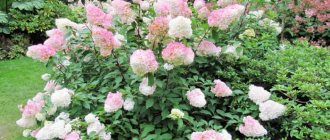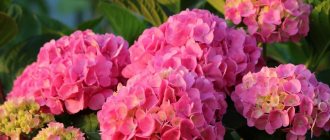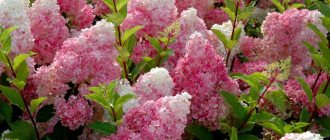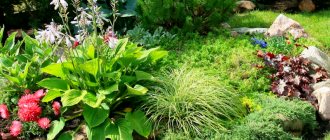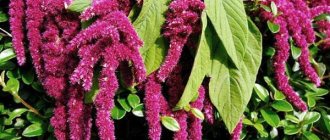Features and Specifications
There are many theories filled with romance and history about the origin of the name hydrangea. The Latin name comes from the Greek words “hydro” - “water” and “angelon” - “vessel”, since all types of hydrangeas need an abundance of moisture.
Hydrangea (lat. Hydrángea) is a genus of flowering plants in the Hydrangeaceae family, including approximately 80 species. The inflorescences of the shrubs consist of large flowers and have four sepals, which during flowering successively change color: green, white, then pink. These sepals act as bait for insects. In addition to the main ones, there are also small flowers that perform the function of reproduction (the so-called fertile sepals).
Among the hydrangeas there are shrubs (they make up more than 85% of the total) up to 3 meters high, about 15% are vines and trees.
The color of the inflorescences is varied. Often depends on the conditions of care, but white, red, pink, lilac and blue shades are known.
Distribution area: South and East Asia, America, in Russia - regions of the Far East.
Why do the inflorescences change color?
Before you turn hydrangea inflorescences blue, you need to understand exactly why this chemical process occurs. The change in color occurs due to the acidity of the soil and the presence of nutrients in it, such as aluminum and phosphorus.
In general, members of the genus Hydrangea macrophylla are susceptible to color change. It is distinguished by large spherical inflorescences and large leaf blades.
Every gardener who wants to change the color of a given crop must take into account the fact that the white tint of flowers is difficult to change. Most often, pink inflorescences are changed to blue or vice versa, and the first option is easier to produce than the second.
Soil acidity
Before planting the shrub in question, the acidity of the soil should be determined.
It is divided into 3 types:
- acidic - pH from 1 to 5;
- neutral - pH from 5 to 7.5;
- alkaline - pH from 7.5 to 14.
For harmonious growth and a change in the color of the inflorescences to blue, the plant in question needs acidic soil. Therefore, before planting it, you need to determine the alkaline composition of the soil. The easiest way to calculate acidity is to use vinegar.
To carry out the procedure you will need:
- tablespoon;
- glass surface (plate, flowerpot);
- vinegar 9%;
- land from the site.
Instructions for determining acidity:
- Use a spoon to scoop up soil from the area where the flower will grow.
- Pour the soil into a glass container.
- Fill the soil with vinegar.
Next, you should observe the reaction that will occur when the earth and vinegar come into contact. If the soil begins to foam a lot, it means it is alkaline. A small amount of foam indicates a neutral pH. A complete lack of reaction means the soil is acidic.
A more accurate way to determine pH would be to use litmus paper. To do this, the gardener will need to purchase test strips from a specialized floriculture store, which come with an acidity scale.
Then collect several soil samples from the site and place them in fabric bags, which are subsequently placed in glasses with distilled water for 5 minutes. After this time, litmus paper is deepened into the water and the result is assessed using the scale attached to the test.
Aluminum
Large-leaved hydrangea secretes a substance called delphinidin-3-monoglycoside, which, when reacted with aluminum, causes the inflorescences to change color to blue. The plant accumulates this chemical element only when the soil acidity is from 1 to 5.5. If the soil pH is neutral or alkaline, then aluminum turns into a sparingly soluble element for shrubs.
Phosphorus
If a gardener wants to change the color of a hydrangea to blue, he needs to ensure that there is no excess phosphorus in the soil. This element turns aluminum into a sparingly soluble substance, and it becomes inaccessible to the plant. Therefore, if you want to change the shade of hydrangea inflorescences, you must follow a clear dosage of phosphorus fertilizer or, if possible, abandon it altogether.
Popular varieties of blue hydrangea
The most common types of large-leaved hydrangea are those with blue and blue flowers.
Blue Wave
It is a shrub with large, wide leaves. Peak flowering occurs in July-August. The color of the flowers ranges from pure white to pale blue, depending on the characteristics of plant care and genetic qualities. White flowers do not change color, but most other colors have the ability to change color.
Blueberry Cheesecake
The shrub is up to 120 cm high, has large flowers with a “double” surface and an intense purple color, often with a creamy-yellow border in the center. The leaves can change color: in summer they are dark green, and by autumn they become dark red.
Hydrangea Mini Penny
A compact shrub with a lush blue inflorescence can change color to delicate pink tones if special care conditions are met. The main positive quality is frost resistance and unpretentiousness.
Jomari
A shrub with a lilac-pink or lilac-blue inflorescence with the effect of a “terry” surface of the sepals and iridescent color. The flowering period is extended - from June to September. A huge plus: new inflorescences appear on new and last year’s branches.
Compeito
A hybrid variety from the land of the rising sun - Japan, literally translated the name means “hard caramel of bright colors.” Modified sepals of a blue or pink hue with a smooth, “caramel” shiny surface. Each shoot has 5-6 inflorescences up to 5 cm in diameter. The lateral surface of the leaves is ribbed with elongated edges.
Ramars
A low, moisture-loving shrub with bright, rich inflorescences: the most famous are dark blue, light blue, purple and violet flowers. The pleasing appearance is complemented by the multiple scalloped edges of the petals and the frame layering of inflorescences on the shoots.
Spike Blue
A shrub crop characterized by fairly rapid growth, a patterned frame and a “terry” leaf surface. The color of the inflorescences is deep crimson, they are distinguished by a special “lace” decoration. It is a remontant variety, so the flowers are located on current and last year's shoots.
Freedom
Compact but voluminous shrubs with shoots framed by finely defined petals of inflorescences. Unusual color of the leaves: the edges are painted in a delicate pale Creole shade, and the core is deep pink. A huge advantage is the special strength of the shoots, which protects garden crops from gusts of wind and strong rain streams.
Hopcorn Blue
One of the recently bred varieties of hydrangea is blue. This is a bush of moderate height with lush inflorescences collected in the form of “hemispheres” (or popcorn). Rounded petals of bright blue color give the plant a colorful look and create a pleasant decor for the garden. A special merit of the breeders is the high resistance of this species to fungal diseases.
Common plant varieties with blue inflorescences
Mini Penny
The most compact type of representatives of this species. Height 60-90 cm. If the alkali content in the soil is high, the flowers may acquire a pink tint. A very light-loving bush, resistant to diseases. It has a long flowering period: from July to September.
During cold weather, it is necessary to cover the bush, since next year the flowering may not be as abundant.
Serrated Bluebird
A very tall one and a half meter bush, the color can vary from blue to pink, depending on the acidity of the soil.
Freedom
A very interesting variety, initially the flowers are white and pink, then they turn blue. At the same time, the plant may have differently colored flowers. Inflorescences can reach 15 cm. Feels great in the shade and loves abundant watering.
Romars
A bush whose height reaches 80 cm. Its distinctive feature is multi-colored buds. These can be blue, white-blue, purple inflorescences. Loves moist soil and shade.
Compeito
A very beautiful representative of the hydrangea species. The inflorescences are lilac-blue, the center is white. Like other varieties, it does not like sun and drought.
Planting and caring for blue hydrangea in open ground
When planting blue hydrangea in open ground, you need to know certain rules and provide appropriate care.
Selecting a planting site and preparing the soil
First of all, you need to choose a variety. Taking into account the characteristics of a certain type of hydrangea, you can begin to select the area: open sun on the site, partial shade or a shaded corner.
The choice of soil requires a detailed approach. It is imperative to determine the pH of the soil. After all, not only the growth of plants, but also the shade of the inflorescences depends on these indicators. Before planting, the soil should be fertilized with ready-made mixtures or prepared fertilizers yourself.
Criteria for soil readiness for planting:
- the soil must be well drained and moist;
- layers of planting soil have a certain ratio: humus, leaf soil, peat chips, river sand;
- pH level in the range of 5.0-5.2.
Planting a plant in open ground
The optimal depth of the hole is 60-65 cm. The soil must be thoroughly saturated with water, including the surrounding area. Cover the bottom of the hole with the prepared soil and lower the seedling into the soil, if you are using a seedling. The next mandatory step is abundant watering, manual compaction of the soil around the new planting and mulching; the choice of material for mulch remains with the gardener (peat, sawdust, tree bark).
It is worth considering the distance between plants if there are several seedlings: it should not be less than 1 meter. A denser planting of the crop contributes to excessive shading, increases competition between roots for moisture and interferes with the normal growth of hydrangea.
Caring for ornamental shrubs
Mandatory conditions for caring for hydrangea are weeding and loosening the soil. The frequency and volume of watering depend on the type of plant. To prevent excessive evaporation of moisture, the shrub is mulched.
Feeding hydrangeas occupies a key place in care: it is recommended to use complex fertilizers in the autumn, and in the spring to use a urea solution.
The correctness of care can be assessed during flowering - this will be evidenced by large leaves, inflorescences rich in shades and strong shoots.
Preparing for winter
Even the most unpretentious plant requires detailed and timely care for the winter. Although some varieties of hydrangea are frost-resistant, they need to be protected from the cold.
Trimming
After flowering, cut off all dry inflorescences on the shoots to reduce the weight of the branches in winter with the additional weight of snow and ice.
For all non-large-leaved species of hydrangea, autumn thinning pruning of shoots is mandatory. This approach allows you to get more lush inflorescences and shrubs for the next season.
Large-leaved varieties of garden crops require spring pruning, which is due to the characteristics of flowering on new and last year's shoots.
How to cover blue hydrangea for the winter
Frost-resistant varieties - tree and paniculata - are not covered, they are only lightly hilled in preparation for winter. Large-leaved varieties require careful protection from the oncoming cold, as they do not have sufficiently resistant qualities. To do this, use an air-dry shelter:
- the branches of the bush are tied and wrapped with spunbond;
- form a frame mesh around the plant;
- the cavity of the frame is filled with dry leaves to the very top;
- then, using any moisture-proof material, they form an additional cover for the bush.
After such actions, the shrub is ready for wintering.
Reproduction methods
A huge selection of blue hydrangea varieties determines the characteristics of reproduction. But still, gardeners identify five main methods:
- Cuttings . They use fairly large bushes from which green cuttings are taken. The resulting material is soaked in a solution of a growth stimulator and then rooted.
- Application of seeds . The process is lengthy, with many obstacles and difficulties. But with positive dynamics, you can get a large yield of seedlings. Frost-resistant varieties are sown directly in open ground during the period - late April - early May. Non-persistent types of hydrangea require planting seeds in a container.
- Reproduction by layering . Select bushes with an abundance of lower layers, then in a rut about 20 cm in diameter, dig in the middle of the shoot. The procedure is carried out in the spring, before flowering begins.
- Reproduction by offspring . Side shoots that have quickly grown a root system can be separated from the “mother” bush. This is done in the fall, before frost sets in. It is not recommended to plant “babies” in open ground, so they are left in pots until spring.
- Bush division . The most accessible method used when replanting a plant. Usually the bush is divided into 2-3 parts, but care is taken that each independent part contains a formed root system and several growth points.
Color Changing Technology
Start of the process
Why do hydrangeas have pale leaves - what should I feed them with?
Before you start painting hydrangeas, you need to determine the acidity of the soil. To do this, use special means or turn to folk methods. If you want to have hydrangeas of different shades, experienced gardeners recommend growing them in different containers. This makes it easier to maintain the soil acidity required for each color.
Hydrangeas in pots
Soil testing
Sometimes the soil does not need to be tested. The appearance will tell about its properties:
- red tints on the surface, reminiscent of rust, indicate that it is highly acidic;
- after watering, a film forms on the water, which shimmers in the sun, which means the reaction is acidic.
If there is a device that allows you to determine the exact value of soil quality, then you can predict the color of the plant in the future. Provided no additional funds are deposited:
- pH about 7.5 – bright pink inflorescences;
- pH less than 4.5 – a blue tint will remain or appear;
- pH in the range from 5.5 to 6.5 - the flowers will become purple or pink and blue on the same bush at the same time, you will get colored hydrangea.
Application of drugs
There are several ways to change soil acidity:
- When planting, add acidic peat, for example, pine bark, to the top layer;
- Feed with special fertilizers that acidify the soil;
- Mulch with peat and pine needles. This means that you need to add these materials to the surface of the soil in order to change its properties in this case. Thus, mulching is also used to protect against pests and diseases, and not only natural materials are used, but also artificial ones, which are crushed to the desired size.
Diseases and pests of blue hydrangea
The plant is often subject to white and gray rot. The disease affects the root system, leaves and stems, leaving perforations where the fungal mass lives.
Powdery mildew damages leaves, especially the border, causing rapid leaf loss.
But not only microflora can cause hydrangea diseases. Damaging factors also include:
- bright scorching sun;
- excessive or insufficient watering;
- lack of fertilizers;
- reduced soil acidity;
- low environmental humidity;
- insufficient iron content in the soil (chlorosis).
Do you like blue hydrangea?
Yes
No
Mistakes when watering hydrangeas, how to avoid them
Soil acidification promotes easy absorption of iron, which will have a beneficial effect on the health of the plant body. Microelement deficiency causes leaf chlorosis. The disease manifests itself as yellowing of the plate, while the central and lateral veins remain green.
The yellow leaf cannot “feed” the plant, because it lacks chlorophyll. Thanks to this pigment, food is obtained through photosynthesis. If there is not enough chlorophyll, the hydrangea begins to starve, uses up reserves, and then dies.
If you constantly water the shrub with chemicals after transplanting, you cannot plant anything in this area.
Conclusion
Proper watering of hydrangea is not only a guarantee of its health, but also an excellent tool for creating a unique flowering shrub. Knowing how to add certain components will help you get the flower of your dreams.
How to change the color of a hydrangea to blue
The color of the inflorescence can be controlled. You can get the rich blue color of the petals only from large-leaved hydrangea. The color changes under the influence of soil pH, the level of aluminum compounds and minerals in the soil.
The petals will turn blue if three conditions are met:
- pH below 5.5;
- the presence of free aluminum, which is formed from its salts only in an acidic environment;
- minimum phosphorus content, since this macroelement promotes the reverse binding of aluminum in its salt.
Two-faced beauty
What gives more saturated shades to blue or pink? If the hydrangea is already in bloom, there is no need to try to add additional coloring agents. Flowers cannot change while they are blooming. Shade may vary.
And they influence this:
- environmental variability;
- plant stress resistance;
- instability of weather conditions.
If special fertilizers containing aluminum are constantly being fed, and the bush does not turn blue, you should pay attention to the surroundings and buildings. If there is a concrete fence nearby, there are concrete slabs, there is a concrete path, then the fault is in the lime washed out of them by rains
Changing the acidity of your hydrangea soil is how you can change the color on your hydrangea, but it's a job that requires persistence and cycles. How to get blue from a rose-flowering shrub is described above. But as practice shows, with the same solution of aluminum alum at the rate of 5 - 10 g per 1 liter of settled or rainwater, dark pink shades can be obtained - lilac, and from red - purple. “Creative” gardeners claim that such fertilizing can be replaced by old nails stuck into the ground or “fertilizing” the soil with iron filings.
When wondering how to change the color of a hydrangea so that it appears in two shades at once, you need to know a few rules described above.
Now any reader of this article knows how to change the color of a hydrangea. This “capricious chameleon of flora” can only “obey” the actions of a competent specialist.
Under the influence of external conditions, hydrangeas gain the ability to change their traditional color and turn into different colors. The property of changing color has been widely used in gardening. In order to use it, you need to know why this happens, how to paint a hydrangea and what to water the hydrangea to change color.
Using hydrangea in landscape design
Thanks to the huge variety of varieties, colorful range of colors and abundance of forms, blue hydrangea has earned a place of honor in the works of landscape designers. Lush bushes and curled vines make up unique compositions in the works of masters. Designers give preference to varieties such as Pinky Winky, Anabelle, and Phantom. Hydrophilicity and love for shaded corners dictate the need to plant hydrangeas under the protection of structures and small buildings, which makes it possible to use trellises, fences, fences and steles in designer decorations.
The beauty of your favorite garden is reality, not fiction. The marvelous patterns of broad-leaved and “double” hydrangeas allow you to create contrast against the background of the bright colors of the inflorescences. By following a number of simple rules of care, you can get a brilliant garden that will delight you with flowering.
Flower propagation process
Propagation of hydrangea through cuttings. They should be rooted from mid-June to July (around 15-20). Young, semi-lignified cuttings of the current year are taken. To root a plant, be sure to keep it in zirconium or heteroauxin for 24 hours before planting. Afterwards, the cuttings are planted in a mixture of peat with the addition of perlite. It is advisable to plant in a transparent container so that the root system can be observed.
If the cutting has already developed it, then it can be transplanted into the ground, or into a shkolka, or buried directly in the pot, making holes on the sides so that the water does not stagnate
When planting it, it is important to remember that one internode remains in the ground and two or three of them are on the surface. At the end, sprinkle a little peat on top
The leaves on the cuttings are trimmed to prevent evaporation of excess moisture.
Seven daily habits of happy people
From athletes to Hollywood stars: men Naomi Campbell
“Olga” from the series of the same name: the tragic fate of actress Yana Troyanova
Landing
Almost all varieties of blue hydrangea prefer shade. They should not be planted in areas that are too brightly lit. Otherwise, there is a high probability of oppression of the culture and the cessation of its growth. It is best to carry out planting work in the middle or end of May.
To plant hydrangeas, you should follow these steps:
- Make a hole 40 cm deep and 60 cm wide. If you plan to plant flowers in a row, it is better to dig a trench.
- The day before planting, it is recommended to water the hole well. For 1 hole you need to use 3 buckets of water.
- Make a nutrient mixture based on peat and humus to fill the hole. You can add 50 g of mineral fertilizer to it.
- Place the hydrangea in the center of the hole and carefully cover it with soil. The soil should be compacted carefully by hand. It is important that the root collar is located on the surface of the soil.
- Water the soil. In this case, the water should well moisten the earthen ball.
- Sprinkle the soil with a small amount of mulch. Its role can be played by peat or bark.
Large-leaved hydrangea, care
Large-leaved hydrangea has its own characteristics, and it is much more difficult to care for than the previous two. But I have already shared my bushes with so many friends, relatives and acquaintances. And the overwhelming majority of them do not regret at all that with the appearance of this hydrangea in the garden, more trouble has been added - the flowering pays for all the costs. So what is this plant?
It is worth distinguishing between the garden and indoor varieties. The one sold in flower shops is very heat-loving and will have difficulty growing and blooming in the garden. You need to buy large-leaved hydrangea at garden centers.
Large-leaved hydrangea blooms on last year's shoots. This means that the buds from which branches with flowers at the top will appear must overwinter. And these buds are located not at the base of the bush, but closer to the top. The more branches and preserved buds there are on the bush, the more abundant the flowering.
Accordingly, large-leaved hydrangea cannot be pruned at all (except for dried branches), and in order for the buds to survive, they should not be exposed to frost. That is, this hydrangea must be carefully covered for the winter. And one more consequence: you won’t be able to cut this hydrangea for bouquets - the more buds you leave, the more magnificent it will bloom next year.
It is also important that large-leaved hydrangea loves shade and moisture more than others. In a sunny place, delicate inflorescences dry and burn, and also fade faster
Even in strong shade, this hydrangea blooms quite well, and in partial shade it is simply an ideal place. At the same time, it rarely needs separate watering (unlike, say, rhododendrons), only in very dry summers.
